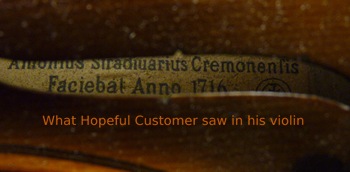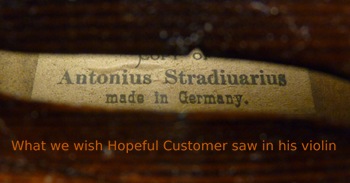Master Hand Violin Shop
Store Hours
Owner
Elizabeth Ecklund
Elizabeth Ecklund
Every so often, we have a customer come into our store with his chest puffed out in anticipation as he presents us with an instrument he hopes will make him filthy rich. Maybe he found it hidden in a closet. Maybe he bought it on ebay or from a flea market for his daughter. Maybe he doesn't know where it came from. What he does know is that this violin is labeled "Antonius Stradivarius", and he'll be darned if he gets less than several million dollars for it. Unfortunately for Hopeful Customer, this violin is never a Stradivarius. Even when he was alive, Stradivarius was too well reputed to sell his violins cheaply. If someone in the family owned a Strad, then he and the whole family knew it, too. So how come Hopeful Customer thinks he has a Strad violin when he most certainly does not? Clearly, the violin has a false label.

False labels are a surprisingly baffling concept for many Americans. Despite the knock-offs we see being hawked on street corners, we are convinced that labels on goods are accurate. By and large, this confidence is a good thing; who would want to be wary of grocery products? We feel safe with labels we see because for over 120 years it has been illegal to inaccurately label any goods (including violins) that are destined for import into the United States. In 1890, William McKinley approved a tariff that, in addition to many other things, required this labeling [from section 6]:
"That on and after the first day of March, eighteen hundred and ninety-one, all articles of foreign manufacture, such as are usually or ordinarily marked, stamped, branded or labelled, and all packages containing such or other imported articles, shall, respectively, be plainly marked, stamped, branded, or labeled in legible English words, so as to indicate the country of their origin; and unless so marked, stamped or branded, or labeled they shall not be admitted to entry."This bill later became known as the Truth in Labeling Law. It was amended in 1914 so that all imports were required to say "Made in" in addition to including country of origin. It was further amended in 1921 so that all imports must include country of origin in English. Thus, Sachsen became Saxony and Nippon became Japan.

Why do we at Master Hand care about the Truth in Labeling Laws? Well, for one thing, they help us identify and date instruments. This labeling is certainly not the only consideration for dating an instrument; instruments in the United States not originally intended for the US typically don't include this labeling. And sometimes labels get changed or altered over time. But if we think a violin is from around WWII and the label says "Made in West Germany", we know it was produced slightly after the war.
Where does this leave Hopeful Customer and his violin languishing from hundreds of years without Truth in Labeling Laws? While he most definitely does not have a Strad, he does have a ray of hope; he may very well have a pretty decent violin worth a few to several thousand dollars. Violins that sold for $10 in 1890 can fetch a pretty penny today if they are in good condition.
Share on Facebook